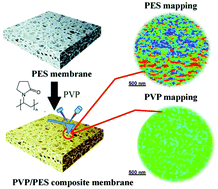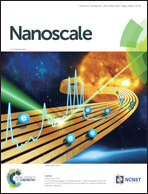Visualizing and quantifying the nanoscale hydrophobicity and chemical distribution of surface modified polyethersulfone (PES) membranes†
Abstract
Chemical modifications bring unique properties into polymeric membranes that may have enhanced filtration or separation efficiencies, antifouling, antimicrobial activity and selectivity. However, there is a lack of nanoscale characterization of the chemical additive distribution and the impacts of chemical modifiers or additives on membrane surface properties, especially those at the nanoscale. In this study, a series of industrially relevant polyethersulfone (PES) membranes modified with poly (ethylene glycol) (PEG) and polyvinylpyrrolidone (PVP) were analysed systematically. Particularly, hydrophobicity and chemical distribution were scrutinized by atomic force microscopy (AFM) and AFM coupled with infrared analysis capability (AFM-IR) for the first time that successfully resolved nanoscale structural and chemical properties of the chemically modified PES membranes. Our results indicated the heterogeneous spatial distribution of PVP and PEG based on their characteristic IR bands and the resulting hydrophobicity distribution on modified membrane surfaces at the nanoscale. Particularly, we established a linear correlation (R2 = 0.9449) between the measured adhesion force and water contact angles, which enabled the examination of local surface hydrophobicity. The PES membranes became more hydrophilic with the increasing blend of PVP and PEG. With AFM-IR, trace amounts (1–4%) of PVP could be identified sensitively on PES membranes based on their unique characteristic IR bands, which were not achieved by FTIR or IR mapping. Overall, these novel characterization approaches hold paramount importance for the design and quality control of polymer membrane modification and manufacturing.



 Please wait while we load your content...
Please wait while we load your content...